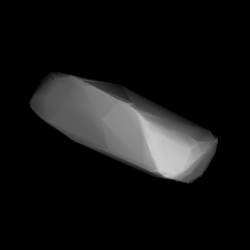Astronomy:341 California
 Shape model of California | |
| Discovery | |
|---|---|
| Discovered by | Max Wolf |
| Discovery site | Heidelberg Obs. |
| Discovery date | 25 September 1892 |
| Designations | |
| (341) California | |
| Named after | California |
| 1892 J; 1979 FY2 | |
| Minor planet category | Main belt |
| Orbital characteristics [1] | |
| Epoch 31 July 2016 (JD 2457600.5) | |
| Uncertainty parameter 0 | |
| Observation arc | 113.45 yr (41,439 d) |
| |{{{apsis}}}|helion}} | 2.62698 astronomical unit|AU (392.991 Gm) |
| |{{{apsis}}}|helion}} | 1.77187 AU (265.068 Gm) |
| 2.19943 AU (329.030 Gm) | |
| Eccentricity | 0.19439 |
| Orbital period | 3.26 yr (1,191.4 d) |
| Mean anomaly | 15.6325° |
| Mean motion | 0° 18m 7.783s / day |
| Inclination | 5.66900° |
| Longitude of ascending node | 29.0469° |
| 293.875° | |
| Physical characteristics | |
| Dimensions | 14.67±0.9 km [1] 15 km [2] |
| Mean density | ~2.7 g/cm3[3] |
| Rotation period | 317.88 h (13.25 d) |
| Geometric albedo | 0.4950±0.064 [1] 0.495 [2] |
| S [4] | |
| Asteroid family | Flora family |
| Absolute magnitude (H) | 10.55 |
California (minor planet designation: 341 California) is an asteroid belonging to the Flora family in the Main Belt. It was discovered by Max Wolf on 25 September 1892 in Heidelberg, and is named for the U.S. state of California .[5] This object is orbiting the Sun at a distance of 2.20 astronomical unit|AU with a period of 3.26 yr and an eccentricity (ovalness) of 0.19. The orbital plane is inclined at an angle of 5.7° to the plane of the ecliptic.[1]
The very slow rotation rate of this asteroid favors collecting photometric data for an extended period in order to measure the period. Data collected from June to December 2016 was used to produce a light curve showing a rotation period of 317.88±0.06 h with a brightness variation of 0.9 in magnitude. It is tumbling with a period of 250±2 h.[6] It has an unusually high albedo.
References
- ↑ 1.0 1.1 1.2 1.3 "341 California (1892 J)". JPL Small-Body Database. NASA/Jet Propulsion Laboratory. https://ssd.jpl.nasa.gov/sbdb.cgi?sstr=341.
- ↑ 2.0 2.1 "Supplemental IRAS Minor Planet Survey". Planetary Data System. Planetary Science Institute. June 23, 2006. http://www.psi.edu/pds/archive/astdata04/simps04/diamalb.tab.
- ↑ Krasinsky, G. A. et al. (2002). "Hidden Mass in the Asteroid Belt". Icarus 158: 98–105. doi:10.1006/icar.2002.6837. Bibcode: 2002Icar..158...98K.
- ↑ PDS spectral class data
- ↑ Peebles, Curtis (2016), Asteroids: a History, Smithsonian, p. 159, ISBN 9781944466046, https://books.google.com/books?id=RbDkCwAAQBAJ&pg=PT159
- ↑ Pilcher, Frederick; Franco, Lorenzo; Pravec, Petr (April 2017), "319 Leona and 341 California - Two Very Slowly Rotating Asteroids", Bulletin of the Minor Planets Section of the Association of Lunar and Planetary Observers 44 (2): 87–90, Bibcode: 2017MPBu...44...87P.
External links
- 341 California at AstDyS-2, Asteroids—Dynamic Site
- 341 California at the JPL Small-Body Database
 |

